WARNING: The following blog contains middle-aged people in rain ponchos. This material is not suitable for all audiences. Viewer discretion is advised.
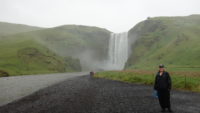 While we’ve not had great weather days much in Iceland (only four days out of thirteen so far with no rain), we’ve had great luck with the rain either being light or stopping whenever we stopped to see something. That streak ended today, as we had light to steady rain until after 5:00 in the evening. But, as the Meredith says, the tour must go on!
While we’ve not had great weather days much in Iceland (only four days out of thirteen so far with no rain), we’ve had great luck with the rain either being light or stopping whenever we stopped to see something. That streak ended today, as we had light to steady rain until after 5:00 in the evening. But, as the Meredith says, the tour must go on!
So, rain or no, we headed back to Skogar, this time to see Skogafoss, the waterfall that is on many bus tour stops. We saw why – it is a large waterfall of about two hundred feet, with good water volume, and it is framed by green cliffs that it cascades over. It’s a classic waterfall, falling straight down into a pool, and of course, it’s only two hours from Reykjavik, making it a good tour stop.
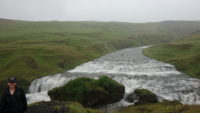 As a bonus, there are five hundred steps or so that take you to the top of the falls to a viewing platform, where we went. To my surprise, there was a trail there. So we walked along it for a half mile or so, finding a lovely second falls that I really loved – it was small and wide and had interesting features – an island, rapids, steps, and such. I thought about going on and then saw a sign that said the bridge was three miles away and some other important point was fifteen miles away. I thought the steps were for tourists, but they are also there for hikers. Because of the steady rain, we turned around. On a nice day, I would have been tempted by the six-mile round-trip bridge hike. I looked on Google Maps, and there are about a dozen named waterfalls on the hike. Next time.
As a bonus, there are five hundred steps or so that take you to the top of the falls to a viewing platform, where we went. To my surprise, there was a trail there. So we walked along it for a half mile or so, finding a lovely second falls that I really loved – it was small and wide and had interesting features – an island, rapids, steps, and such. I thought about going on and then saw a sign that said the bridge was three miles away and some other important point was fifteen miles away. I thought the steps were for tourists, but they are also there for hikers. Because of the steady rain, we turned around. On a nice day, I would have been tempted by the six-mile round-trip bridge hike. I looked on Google Maps, and there are about a dozen named waterfalls on the hike. Next time.
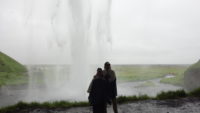 We headed up Route 1 to another famous waterfall, Seljalandsfoss. This is a smaller waterfall in volume, looking a bit puny compared to Skogafoss. But the real draw here is that you can walk behind the waterfall. We planned on doing that, and had been warned that we would get wet, so we donned the very sexy matching ponchos we had brought along and followed the trail up into the mist. It wasn’t very bad – it was similar to many misty rains we have had on this trip already. Our normal jackets that are water resistant probably would have been okay, but I didn’t mind staying dry.
We headed up Route 1 to another famous waterfall, Seljalandsfoss. This is a smaller waterfall in volume, looking a bit puny compared to Skogafoss. But the real draw here is that you can walk behind the waterfall. We planned on doing that, and had been warned that we would get wet, so we donned the very sexy matching ponchos we had brought along and followed the trail up into the mist. It wasn’t very bad – it was similar to many misty rains we have had on this trip already. Our normal jackets that are water resistant probably would have been okay, but I didn’t mind staying dry.
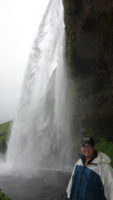 The view from the back was fun, especially when I looked up at where the waterfall seemed to be ejected from the top of the cliff face. It was an odd and unfamiliar view to be under the arc of a falls like that. But Meredith and I both also really enjoyed the waterfall from profile. You could watch water fall the entire two hundred feet down into the pool, and the falls seemed to come in waves or clumps of water that you could trace through the air.
The view from the back was fun, especially when I looked up at where the waterfall seemed to be ejected from the top of the cliff face. It was an odd and unfamiliar view to be under the arc of a falls like that. But Meredith and I both also really enjoyed the waterfall from profile. You could watch water fall the entire two hundred feet down into the pool, and the falls seemed to come in waves or clumps of water that you could trace through the air.
We got back in the car, again grateful for heated seats in late July, and drove on north to the Lava Center in the town of Hvolsvollur. The Lava Center tells the story of Iceland and the volcanic activity over the history of the island. It is interactive and highly up to date, even including the current eruption that has been going on since spring.
The museum greets you with a map of Iceland and wall monitors that show all earthquakes on the island in the last forty-eight hours. That was eye-opening, especially when many quakes seemed to center on Katla, the volcano under the Myrdalsjokull glacier. There have been indications that Katla is gearing up for another eruption, and if a big one comes, it could flood the southern coast with sudden rivers the size and flow of the Amazon.
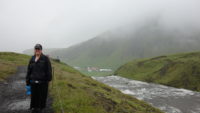 There was a twenty-minute-long video showcasing all the eruptions in the south for the last one hundred years. As an aside, this was the first theater I’ve seen where there were mats laid out in the front so people could lie down to watch the show. All of the volcanoes were impressive, but the eruptions of the last fifteen years were in vivid high-definition videos, which was sobering.
There was a twenty-minute-long video showcasing all the eruptions in the south for the last one hundred years. As an aside, this was the first theater I’ve seen where there were mats laid out in the front so people could lie down to watch the show. All of the volcanoes were impressive, but the eruptions of the last fifteen years were in vivid high-definition videos, which was sobering.
The interactive part of the museum let you move simulated eruptions backwards and forwards on a timeline to see how they worked. The screens were stationed over islands upon which were projected rivers of lava. It was visually quite effective. Another room – the whole room – was a projection of the skyline around the Lava Center which showed the six volcanoes close by (most within twenty-five miles). You could stand on specific spots and learn about the volcano, and use gestures to “go” to points on the mountain to get more information. All the while, each of the six volcanoes erupted in turn, sometimes filling the entire screen with blinding ash.
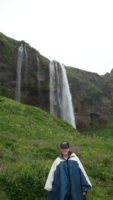 Ash, it turns out, is way more damaging than lava. It covers much more area, and endangers people and animals. Most lava eruptions are not explosive, and even the ones that are violent tend to throw lava only short distances. Of course, some volcanoes erupt with both ash and lava, sometimes for months at a time or longer.
Ash, it turns out, is way more damaging than lava. It covers much more area, and endangers people and animals. Most lava eruptions are not explosive, and even the ones that are violent tend to throw lava only short distances. Of course, some volcanoes erupt with both ash and lava, sometimes for months at a time or longer.
It was a great little museum, and perfect for a rainy day. One startling fact we learned is that Iceland has thirty active volcanoes being monitored. That’s a big number for a country roughly the size of Maine.
After the museum, we stopped off in another town for a combo lunch/supper meal of pizza a little before 5:00. Lunch is often the ignore meal when we tour. Then, on to our hotel in suburban Reykjavik. It was very weird seeing a city again after two weeks of being in very rural areas. Happily, the rain stopped as we approached the city, so we didn’t get wet moving our luggage into the hotel. This hotel is very big and modern, and is the first hotel we’ve been in that has not looked out over a mountain or stream or ocean or all three. We see a highway. But we’ll be here for three nights, so it is good not to have to pack up every day.
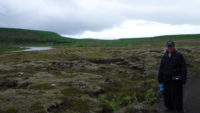 We had to take our return-home Covid tests, and that took almost two hours by the time everything was done, but at least we are officially Covid-free, and so can get on the airplane. It was now 8:00, so rather than make some big trip out and about, we took a two-mile walk in a small nature preserve five minutes behind our hotel. It is a weird thing to be walking though a lava field with suburban buildings all around and being able to hear an outdoor concert in the distance.
We had to take our return-home Covid tests, and that took almost two hours by the time everything was done, but at least we are officially Covid-free, and so can get on the airplane. It was now 8:00, so rather than make some big trip out and about, we took a two-mile walk in a small nature preserve five minutes behind our hotel. It is a weird thing to be walking though a lava field with suburban buildings all around and being able to hear an outdoor concert in the distance.
Having gotten back to the city, we completed our circumnavigation of all of Iceland. The ring road (Route 1) is 825 miles long, but if the rental record was correct on my initial mileage, I drove something closer to 2,400 miles in thirteen days with all of the side trips we took. I told Meredith that next year we are going to Denmark (less than half the size of Iceland). And we have more driving coming tomorrow – Meredith is planning on doing the Golden Circle drive near Reykjavik, which will be another 155 miles. But we are supposed to be rain-free after 9:00 am, so tour on! I won’t be putting the driving into driving rain.